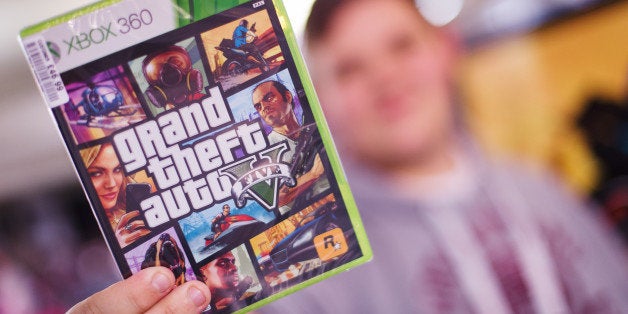
Violent video games don't exist -- in fact, nor do nonviolent video games. That latter point may actually be easier to demonstrate. Given the way the term "violent video games" is defined in the scholarly community, almost all video games are violent video games, including Pac-Man, as a scholar had to admit in one recent court case. My point is that the concept of "violent video games," which society has been debating as long as video games have been around (yes, politicians and scholars once seriously worried over the impact of games like Pac-Man, Centipede and Zaxxon), is so vague that it has little real meaning.
We'd all agree that a game such as Grand Theft Auto 5 is a violent video game, but where exactly do we draw the line between violent and nonviolent games? What about a game like Starcraft, which is mainly a strategy game? Or my son's current favorite video game, Lego Marvel Super Heroes, which involves gruesome (kidding) Lego deaths? If we play competitively in free play, trying to zap each other, is this more violent than following the story narrative? Or was that line between violent and nonviolent crossed long ago with Pac-Man, Centipede, Zaxxon and other "violent" games of the 1980s?
This issue of exactly what is a violent video game (along with the poor quality of much of the research) bedeviled the U.S. Supreme Court in its 2011 Brown v. Entertainment Merchants Association decision. As became apparent in that case (and in cases before it), much of the scholarly community has come to consider media violence an all-encompassing whole, such that a picture of a gun is as likely to increase aggression as is a violent video game. Much time has been spent debating the merits of the aggression measures used in this research (and see the Supreme Court's majority reaction to them, which was less-than-impressed, to say the least), but the vagueness of the term "violent video game" (or "media violence," for that matter) is also problematic for how the construct is measured in research. Many studies continue to settle for dubious approaches, such as allowing kids to rate how violent the games they play are, then asking them how aggressive they are, an approach that can cause spurious correlations. Other surveys assume that entire genres of games can be reliably scored as violent or nonviolent without even knowing the individual game titles.
Perhaps we might consider M-rated games as the really violent video games (ignoring that whole theoretical bit about how any game violence, or even looking at a picture of a gun, is bad). But here too, a game such as Bioshock Infinite is very different from one such as Grand Theft Auto 5, which is very different from one such as The Walking Dead. The game narratives and the context in which violence occurs are very different. So does the concept of "violent video game" have any meaning at all? If Pac-Man is a violent video game just as Grand Theft Auto 5 is a violent video game, the whole concept is absurd. When we use the term "violent video game," we make an assumption that all games that contain any violent content, no matter how minor, and no matter the context, share some kind of conceptual space that is relevant.
Indeed, I suggest that use of the term "violent video game" survives, both in the general public and in the scholarly community, not because it has actual conceptual utility but because it is emotionally loaded. We might be willing to celebrate and defend the artistic and social merit of individual M-rated games such as Bioshock, Halo 2, Mass Effect 2 and Fallout 3 (all of which were recognized as art by the Smithsonian Institute), but defending "violent video games" as a concept is, emotionally, a little like defending "porn" as a concept. In the research community, the widespread use of such emotionally laden terminology can easily set up researcher expectancy effects that can influence social science results. Such terms arguably also put pressure on professional advocacy groups such as the American Psychological Association (APA) that may be reluctant to appear to defend such emotionally described media by doing anything other than condemning it, whatever the data may say.
But, ultimately, I argue that the concept of "violent video games" has about as much conceptual utility as "blond people" does in informing us about the characteristics of individual women and men. Our insistence on treating the concept of "violent video games" as something meaningful has succeeded mainly in keeping debates on video games emotional rather than rational. Furthermore, I argue that such terms have maintained researchers' focus on an emotionally loaded Holy Grail in trying to link such media to an array of public health outcomes. Too often, this has functioned as a block to a sophisticated program of research examining the specific and idiosyncratic ways in which specific game design elements interact with specific users' wants and needs in ways that are probably both more interesting and valuable. We can only hope that a new, nuanced, more balanced approach such as that recently suggested by Isabella Granic and her colleagues in the APA's flagship journal will hold sway in future research.
